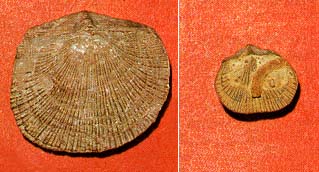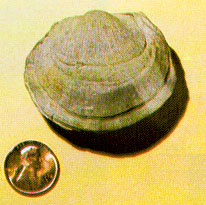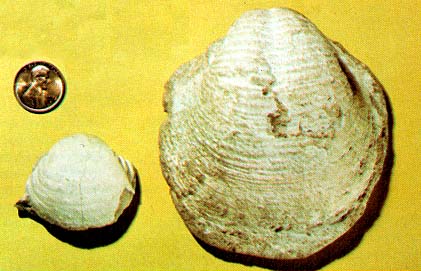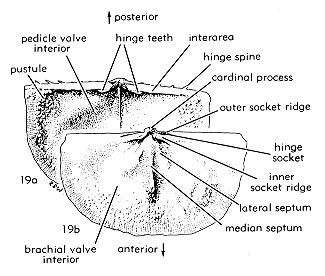



Ancient Life in Kansas Rocks, part 12 of 27

Two examples (large and small) of Derbyia, a strophomenid type of brachiopod, are shown in this photo (slightly enlarged). Derbyia has well defined interareas (the broadly triangular portion of the valve adjacent to the hinges). It is biconvex with a convex pedicle valve and a nearly flat brachial valve. (Beil Limestone, Upper Pennsylvanian)
Derbyia, a large specimen of which is at the upper left, is common in the Pennsylvanian and Permian rocks of Kansas. This specimen is typical of Permian Derbyias which are substantially larger than their Pennsylvanian ancestors, an example of which was shown in the first photo. (Florena Shale, Permian)

Two more brachiopod genera are shown in this figure, Juresania the top two and Meekella the bottom three (photograph slightle enlarged). Both of these fossils have characteristics that are relatively easy to identify. Juresania is a productid type of brachiopod and as such has a spinose concavo-convex shell. The pedicle valve is typically highly convex. (Beil Limestone, Upper Pennsylvanian)

Meekella is quite easily recognized. Assigned to the strophomenids, the side view in the center reveals that it is biconvex, has a pronounced triangular interarea (lower right), and lacks spines, thus distinguishing it from the productids. Meekella's deeply conical pedical valve is distinctive, and it may have been cemented to the sea bottom. (Beil Limestone, Upper Pennsylvanian)

Linoproductus on the left and Echinaria on the right are both productid brachiopods. The productids characteristically have a straight hinge line and a brachial valve (hidden from view here) that is flat or even concave. Another common feature is the presence of spines. These specimens also possess another feature that gives them a scallop-like appearance, that of the outward-flaring shell in the area of the hinge.
Echinaria is recognized by its large size, concentric rows of short spines, and shallow sulcus or depression running down the center of the pedicle valve. Linoproductus, on the other hand, has long, fine radiating costae and concentric rows of more widely spaced spines. (Echinaria, Stanton Limestone, Upper Pennsylvanian; Linoproductus, Farley Limestone, Upper Pennsylvanian)
In the next photo, Chonetinella are chonetid brachiopods (shown slightly enlarged). Extremely common in Pennsylvanian rocks, they are readily distinguished from other brachiopods described in this book by their small size, shape, and flattened form.

Note the hinge spines on both Chonetinella and the next brachiopod, Neochonetes. These spines served to balance or attach the adult shells to the sea bottom in a concave-upward position. With shells as flat as these, the volume of the soft body within must have been very small.

Chonetinella may be identified by its small size, its pedicle valve which is divided by a pronounced sulcus into two lobes (right in photo) and a well-defined central ridge (termed a medium septum) in the interior of the brachial valve (center in photo). (Chonetinella, Kansas City Group, Upper Pennsylvanian)
Another very common chonetid brachiopod, Neochonetes is also distinguished by its size, elevated medium septum (right top in photo), inner and outer socket ridges, and fine radiating ridges on the exterior of the shell. (Neochonetes, Florena Shale, Lower Permian)

Kansas Geological Survey
Placed online Feb. 1997
URL = "http://www.kgs.ku.edu/Publications/ancient/f12_stroph.html"
Send comments and/or suggestions to webadmin@kgs.ku.edu